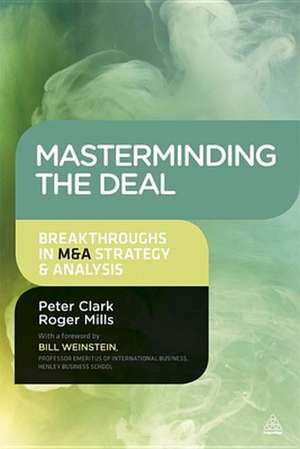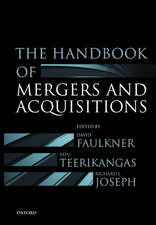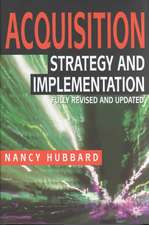Masterminding the Deal – Breakthroughs in M&A Strategy and Analysis
Autor Peter Clark, Roger Millsen Limba Engleză Paperback – 2 aug 2013
| Toate formatele și edițiile | Preț | Express |
|---|---|---|
| Paperback (1) | 442.50 lei 43-57 zile | |
| Kogan Page – 2 aug 2013 | 442.50 lei 43-57 zile | |
| Hardback (1) | 1280.39 lei 43-57 zile | |
| Kogan Page – 2 ian 2015 | 1280.39 lei 43-57 zile |
Preț: 442.50 lei
Preț vechi: 497.20 lei
-11% Nou
Puncte Express: 664
Preț estimativ în valută:
84.67€ • 88.64$ • 70.06£
84.67€ • 88.64$ • 70.06£
Carte tipărită la comandă
Livrare economică 07-21 aprilie
Preluare comenzi: 021 569.72.76
Specificații
ISBN-13: 9780749469528
ISBN-10: 0749469528
Pagini: 352
Dimensiuni: 156 x 233 x 21 mm
Greutate: 0.51 kg
Editura: Kogan Page
ISBN-10: 0749469528
Pagini: 352
Dimensiuni: 156 x 233 x 21 mm
Greutate: 0.51 kg
Editura: Kogan Page
Cuprins
List of figures and tables
About the authors
Foreword by Bill Weinstein
Preface
Introduction
01 The next merger boom is already here
1.1 Business-merger waves: patterns, theories on causes, issues
1.2 Four post-1980 four business-merger waves, four phases
1.3 The fourth (and final?) post-1980 wave is already underway
1.4 Merger wave issue I: (T)APP-synergy divergence as the wave progresses
1.5 Merger wave issue II: whipsaw-merger market entry and exit missteps
02 Debunking the six merger fallacies that destroy value
2.1 Increased understanding of historical merger failure means that would-be acquiring firms are more inclined to avoid mergers
2.2 Significant increases to target company’s debt levels do not significantly reduce the probability of the related deal’s success
2.3 The heroic figure in the acquisition drama is the all-conquering acquirer, while shareholders of the acquired company are victims, with their firms accurately depicted as led by underperforming managers
2.4 There is no inherent conflict of interest between dealmakers and other parties compensated on the basis of fees earned upon deal closure, and the interests of acquiring firms’ shareholders
2.5 Price-to-earnings and similar multiples techniques are the leading merger valuation methodologies
2.6 Stories and process: PMI success is primarily a matter of sound process and responsive organization
03 Criteria: First, get the merger valuation methodology right
3.1 You can’t manage what you can’t measure especially when it comes to M&A
3.2 Criteria-setters: preeminence of continuing shareholders of the acquiring firm
3.3 Overview: four alternative merger valuation methods
3.4 Event studies (ES): exceeding the limits of rational market theory
3.5 Total shareholder return (TSR): most appropriate for round turn financial acquirers?
3.6 Value gap (VS): do synergies offset the price premium necessary to acquire the target?
3.7 Incremental value effect (IVE): two-scenario DCF analysis, adapted to mergers
3.8 Reconciling the tier I merger valuation methodologies
3.9 Multiples: critical confirmation role in merger valuation
04 Merger segmentation comes of age
4.1 The case for segmentation by merger type: precedent
4.2 Four categories, nine merger types: different deal types mean different M&A success
4.3 Applying the nine merger type framework
4.4 The path forward in merger segmentation: towards M-Score©
05 Mergers still fail, but does it matter?
5.1 More confirmation that historically, most mergers fail
5.2 No effective refutation of MMF
5.3 M&A’s core contradiction, segmentation and stakeholders’ different merger perspectives
5.4 Moving forward: expanding upon Hayward’s three causes of merger failure
06 The merger megaboom’s signature IPO: Facebook
6.1 The straw that stirs the drink
6.2 Social networking and the 2011–19 merger megaboom
6.3 Direct and indirect merger market effects of social networking sector acquisitions, 2011+
6.4 Vapor numbers: when is the social networking valuation?
07 Towards systematic investigation and implementation of post-merger synergies
7.1 Synergies: definitions, approaches, issues
7.2 Net realizable synergies and merger success: value gap revisited
7.3 A key category-based net realizable synergy investigatory framework
7.4 Post-merger priorities explored
7.5 Other PMI implementation issues: choosing the PMI implementation team
08 The seven keys to merger success
8.1 Merger success: the seven keys
8.2 Some implementation considerations
Epilogue
Appendix A: Acquisition purchase premium-related issues
Appendix B: Debunking the extreme acquisition leverage fallacy
Bibliography
Acronyms and glossary
Index
About the authors
Foreword by Bill Weinstein
Preface
Introduction
01 The next merger boom is already here
1.1 Business-merger waves: patterns, theories on causes, issues
1.2 Four post-1980 four business-merger waves, four phases
1.3 The fourth (and final?) post-1980 wave is already underway
1.4 Merger wave issue I: (T)APP-synergy divergence as the wave progresses
1.5 Merger wave issue II: whipsaw-merger market entry and exit missteps
02 Debunking the six merger fallacies that destroy value
2.1 Increased understanding of historical merger failure means that would-be acquiring firms are more inclined to avoid mergers
2.2 Significant increases to target company’s debt levels do not significantly reduce the probability of the related deal’s success
2.3 The heroic figure in the acquisition drama is the all-conquering acquirer, while shareholders of the acquired company are victims, with their firms accurately depicted as led by underperforming managers
2.4 There is no inherent conflict of interest between dealmakers and other parties compensated on the basis of fees earned upon deal closure, and the interests of acquiring firms’ shareholders
2.5 Price-to-earnings and similar multiples techniques are the leading merger valuation methodologies
2.6 Stories and process: PMI success is primarily a matter of sound process and responsive organization
03 Criteria: First, get the merger valuation methodology right
3.1 You can’t manage what you can’t measure especially when it comes to M&A
3.2 Criteria-setters: preeminence of continuing shareholders of the acquiring firm
3.3 Overview: four alternative merger valuation methods
3.4 Event studies (ES): exceeding the limits of rational market theory
3.5 Total shareholder return (TSR): most appropriate for round turn financial acquirers?
3.6 Value gap (VS): do synergies offset the price premium necessary to acquire the target?
3.7 Incremental value effect (IVE): two-scenario DCF analysis, adapted to mergers
3.8 Reconciling the tier I merger valuation methodologies
3.9 Multiples: critical confirmation role in merger valuation
04 Merger segmentation comes of age
4.1 The case for segmentation by merger type: precedent
4.2 Four categories, nine merger types: different deal types mean different M&A success
4.3 Applying the nine merger type framework
4.4 The path forward in merger segmentation: towards M-Score©
05 Mergers still fail, but does it matter?
5.1 More confirmation that historically, most mergers fail
5.2 No effective refutation of MMF
5.3 M&A’s core contradiction, segmentation and stakeholders’ different merger perspectives
5.4 Moving forward: expanding upon Hayward’s three causes of merger failure
06 The merger megaboom’s signature IPO: Facebook
6.1 The straw that stirs the drink
6.2 Social networking and the 2011–19 merger megaboom
6.3 Direct and indirect merger market effects of social networking sector acquisitions, 2011+
6.4 Vapor numbers: when is the social networking valuation?
07 Towards systematic investigation and implementation of post-merger synergies
7.1 Synergies: definitions, approaches, issues
7.2 Net realizable synergies and merger success: value gap revisited
7.3 A key category-based net realizable synergy investigatory framework
7.4 Post-merger priorities explored
7.5 Other PMI implementation issues: choosing the PMI implementation team
08 The seven keys to merger success
8.1 Merger success: the seven keys
8.2 Some implementation considerations
Epilogue
Appendix A: Acquisition purchase premium-related issues
Appendix B: Debunking the extreme acquisition leverage fallacy
Bibliography
Acronyms and glossary
Index
Notă biografică
Peter Clark is a lecturer at University College London, within the Department of Management Science and Innovation, where he teaches finance at both undergraduate and postgraduate levels.
Roger Mills is Emeritus Professor of Finance and Accounting at Henley Business School, University of Reading, and, most recently, was Professor of Fundamental Analysis and Business Valuation at the VU University in Amsterdam.
Roger Mills is Emeritus Professor of Finance and Accounting at Henley Business School, University of Reading, and, most recently, was Professor of Fundamental Analysis and Business Valuation at the VU University in Amsterdam.














